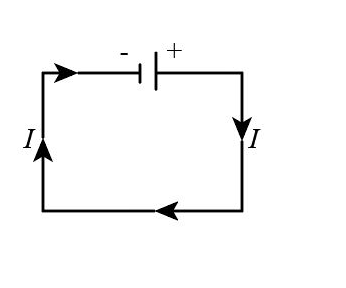
The conventional electric current flows from:
A) Higher potential to lower potential
B) Lower potential to higher potential
C) Both A and B
D) None of these
Answer
462.6k+ views
Hint: The flow of electrons in the wire in unit time is called the electric current. This occurs by the potential across the wire. The potential is the work for the movement of the electron from one position to another position.
Complete step by step solution:
The electron repels the other electron because of their same charge. The electron at the negative terminal of the wire pushes the electron in its vicinity. The electrons flow from negative terminal to positive terminal and the current flows opposite to the flow of the electron. The electron of the negative terminal pushes the other electrons if the potential between the both ends of the wire is different. This difference of the potential is called the potential difference. The potential of the positive terminal is higher than the potential of the negative terminal.
A simple diagram showing the current flow direction from +ve to -ve potential is shown below:

Therefore, the conventional current flows from higher potential to lower potential and the option (A) is correct.
Additional information:
The resistance of the wire resists the current flow in the wire. It depends on the material and dimensions of the wire. The resistance varies with the temperature. If the value of the resistance is very high then the more power dissipated in the form of heat.
Note: Be careful in identifying the positive and negative terminal of the supply because the current flows in the wire from the positive terminal to negative terminal and the direction of flow of electrons is just opposite to the current.
Complete step by step solution:
The electron repels the other electron because of their same charge. The electron at the negative terminal of the wire pushes the electron in its vicinity. The electrons flow from negative terminal to positive terminal and the current flows opposite to the flow of the electron. The electron of the negative terminal pushes the other electrons if the potential between the both ends of the wire is different. This difference of the potential is called the potential difference. The potential of the positive terminal is higher than the potential of the negative terminal.
A simple diagram showing the current flow direction from +ve to -ve potential is shown below:

Therefore, the conventional current flows from higher potential to lower potential and the option (A) is correct.
Additional information:
The resistance of the wire resists the current flow in the wire. It depends on the material and dimensions of the wire. The resistance varies with the temperature. If the value of the resistance is very high then the more power dissipated in the form of heat.
Note: Be careful in identifying the positive and negative terminal of the supply because the current flows in the wire from the positive terminal to negative terminal and the direction of flow of electrons is just opposite to the current.
Recently Updated Pages
Master Class 11 Accountancy: Engaging Questions & Answers for Success

What percentage of the area in India is covered by class 10 social science CBSE

The area of a 6m wide road outside a garden in all class 10 maths CBSE

What is the electric flux through a cube of side 1 class 10 physics CBSE

If one root of x2 x k 0 maybe the square of the other class 10 maths CBSE

The radius and height of a cylinder are in the ratio class 10 maths CBSE

Trending doubts
What constitutes the central nervous system How are class 10 biology CBSE

What are the public facilities provided by the government? Also explain each facility

This cake is sweet that one A As sweet as B Sweeter class 10 english CBSE

Compare the advantages and disadvantages of multipurpose class 10 social science CBSE

Lets have a cup of tea A Havent we B Have we C Will class 10 english CBSE

What are five examples of facts and opinions class 10 english CBSE




